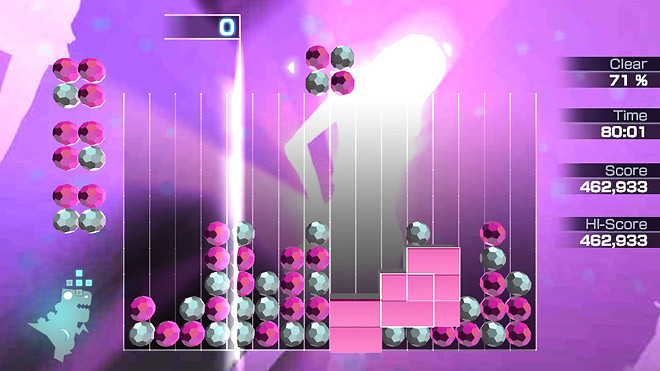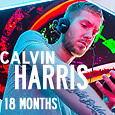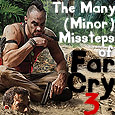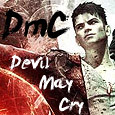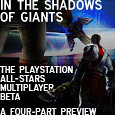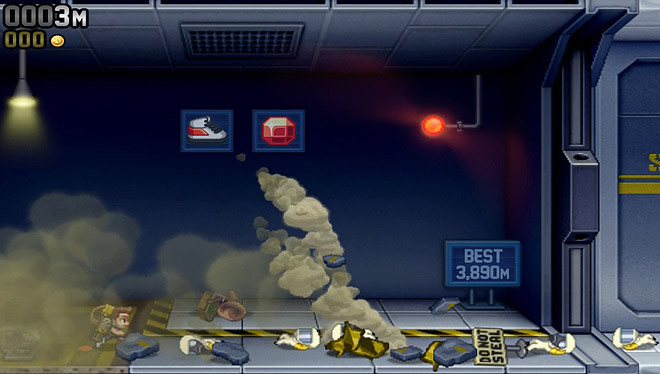
Here was my to-do list when I woke up today:
- Swim some laps at the gym.
- Take out the garbage and the recycling.
- Cut my hair, trim my beard.
- Take a shower.
- Shop for groceries.
- Go to work.
I have done exactly none of those things. Mind you, I'm not going to work because the community college I work for decided to close for snow today (it's not even snowing) but I don't have a good excuse for the other ones. I've just been playing too much Jetpack Joyride.
I initially dismissed Jetpack Joyride as yet another clone of The Helicopter Game, a one-note Flash game my friends and I used to play in high school instead of paying attention in class (until we figured out how to install Quake III Arena on the school laptops). It was incredibly simple—click to lift your chopper or release to let it fall to avoid hitting anything as you fly through a cave—but it was so addicting.
Considering that that game was made in 2003, I couldn't believe how many people have been getting so jazzed about Jetpack Joyride recently. It's the same game!
Actually, it's not. It takes the same premise and applies almost a decade's worth of game psychology to create something even more addicting.
The most significant change is how much easier it is. If you weren't paying attention when you started The Helicopter Game, you could die immediately by touching the bottom of the cave. You had to be on point at all times. Jetpack Joyride is more forgiving.
The hallway you fly through stays totally level the whole time, so you never need to worry about your path slithering up and down, narrowing and opening at random. In fact, you can run on the ground or rub your head against the ceiling all you want as long as long as there's not a laser or a missile in the way; you can get in vehicles that change the way you move and give you a buffer when you get hit; you can buy items that can give you everything from a head start to a second chance when you die.
Jetpack Joyride is a much easier game, encouraging you to keep playing because every run feels like it could be The One. But that's not all.
You can buy unlockable gadgets, borrowing from Call of Duty's addictive Perks system, to give you different abilities like a jump, quicker falling, a missile jammer, and a bouncy ball that deploys when you die to bounce you farther. You can customize your character by buying new outfits and jetpacks to make him your own.
You've probably noticed that I've been using the word "buy" a lot. That's right. I haven't even gotten to the coins yet. Oh god, the coins.
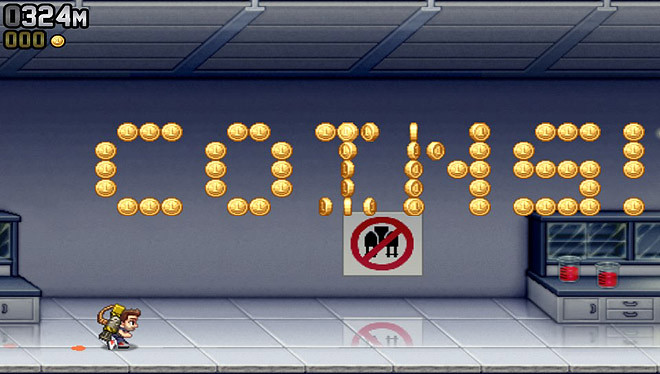
You'll buy everything in the game with coins that you can earn as you play or buy with real money. That's how the game keeps you hooked, how it maintains persistence, how it gets you to play "just one more." You're always so close to buying the next thing that you absolutely need to have and it's just so easy to start another run that you'd may as well play just one more.
Well, that one didn't count because I died in the first 100m. That's hardly a run. Just one more.
The game even borrows the Xbox 360's Achievements by having persistent awards and a rotating set of three missions for you to complete, like collecting a certain amount of coins in one run, dying a specific distance in, or high-fiving the scientists that run along the ground.
You'll want to complete missions, you see, because they unlock stars that will level you up so you can earn more coins to buy more gadgets to make earning coins easier so you can buy more gadgets to make completing missions easier. Get it?
And once you've beaten all the missions, you can erase your mission progress and start over! That's right; you can "Prestige," just like you can in Call of Duty.
It's insane how much has changed over the last decade in what is ostensibly the same game. Now there's even a slot machine. Collect spin tokens as you play and you'll get to spin the wheels.

Imagine that: the game even manages to find a way to use the psychology of gambling to keep you hooked.
It's a beautiful system, really. You win just often enough at the slots that it's almost always worth using your spin token instead of cashing it in for a measly 50 coins. I mean, really, 50 coins? Please. I can make back 50 coins in 15 seconds in another run if this spin doesn't go my way. May as well try for the big money.
It's such a significant part of the experience that the game's ESRB rating actually warns you about the "simulated gambling," and for good reason. In a free-to-play game like this where there's literally no limit to the amount of real money you can spend, that's a prudent warning.
For the most part, the game lulls you into a trance. That's how I can waste half a day on it and not even notice. But I also haven't spent a dime on it.
That's probably because none of the unlocks appeal to me enough, and they're all well in the range of a few days of occasional play. It's a mindset that's almost impossible to break after an entire lifetime of conditioning by games that demand I earn rewards by investing more time and energy, not money. Practice, they tell me. Be patient.
You don't just buy the Master Sword for $2.99. You work for it. You toil. You play for hours and hours before you even get to see it.
Well, in Jetpack Joyride, you do.
Jetpack Joyride applies almost a decade's worth of game psychology to create something even more addicting.
Then again, my reluctance could also be due to the game's technical shortcomings. I'm playing it on the Vita, and it's a workable port, but that's about it.
The biggest problem is that it just looks kind of crummy on the Vita's beautiful OLED screen. There's a distinct lack of crispness and vibrance that I've come to expect from Vita games like Rayman Origins or Gravity Rush. Those games leave me in a constant state of awe. Jetpack Joyride actually hurts my eyes.
That's not an exaggeration. It's the effect that movies have when they slowly pan the camera and everything blurs. Jetpack Joyride is in constant motion, so it always looks blurry and it gives me a headache after a while.
It's hard to feel compelled to pour money into a game that I can't stand to look at for long periods of time.
There's a gadget called "X-Ray Specs" in the game that let you see which vehicle is inside the random pickups along the way, as well as through scientists' clothes and other little novelties. On Vita, if you have the X-Ray Specs equipped, whenever a vehicle pickup appears onscreen, the game takes a huge performance hit and brings the frame rate to a crawl.
In a game like this, the slightest hiccup can mean instant death, so I've had to stop using the Specs altogether.
The best thing I can say about the Vita port is that it smartly lets you use the rear touch screen to play so you don't have to obscure the action with your fingers. A lot of games on Vita are hard to play when they require any kind of precision on that rear touch screen because it's hard to know where your fingers are, but that doesn't matter here. The whole game is controlled with one input, so it doesn't really matter which part of the screen you're touching.
So yeah, it works, but it's definitely not a showpiece title for the system.
But what it does do is latch its hooks into you so you'll want to play it whenever you have a few minutes of spare time. It's quick to load, quick to play, and quick to close. It's in and out of your life in an instant. It doesn't ask you to think or strategize, only react. It is the definition of consumable content.
It takes a mindless Flash game and layers on lessons learned over a decade of gaming to create a monster that earned 35 million downloads before being released on Android or PlayStation devices. It's really quite impressive.
Next time you play Jetpack Joyride—given those numbers, chances are pretty good that you've played it—think about why you're playing it and what makes it successful. Think about what would happen if you stripped away all those extra layers until all that's left is the core of the game. Think about why you've spent money on it if you have or what it would take to get you to spend money it if you haven't.
And then think about how the lessons of a game like Jetpack Joyride have been coming back around to influence the traditional games it originally borrowed from.
 Tweet
Tweet 



